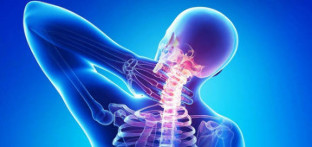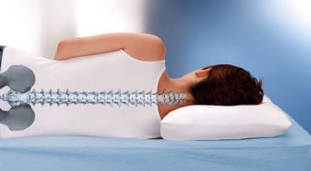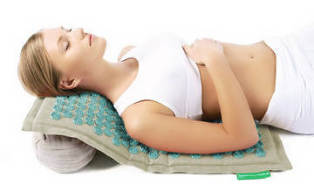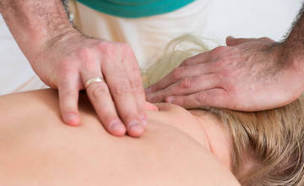
Osteochondrosis of the cervical spine is a progressive process of dystrophy, a disorder of the intervertebral discs.
Symptoms of cervical osteochondrosis are characterized by severe pain in the neck, head, and shoulders and affect everyone, regardless of age.
DESCRIPTION OF THE OSTEOCHONDROSE
The osteochondrosis of the neck has become much younger. Young people suffer from puberty. The neck is the weakest area of the spine. Seven vertebrae are fairly closely spaced, and the skeleton of the muscles is less developed than the rest of the sections. The neck is exposed to serious stress because it serves as a support for the skull and is in constant motion.
What is cervical osteochondrosis? The intervertebral discs are nourished by diffusion from neighboring tissues. A deterioration in the blood supply to the tissues surrounding the vertebrae leads to a lack of food and water. Starvation of the disc nucleus and the annulus fibrosus leads to degenerative processes.
Overgrowing bone tissue near the vertebrae, pinched intervertebral discs, and pinched nerves and ligaments initially appear as signs of decreased performance. High intensity pain initially focuses on the neck, head, shoulders, heart, arms, and upper chest and moves to the lower extremities. Each of the seven vertebrae sends signals to different departments. Compressed nerve roots affect the state of other body systems.
Osteochondrosis is particularly dangerous to the brain. The vertebral artery running here has the function of supplying the back of the brain with blood. Squeezing it together creates a headache, which often turns into migraines and is not pain reliever. Osteochondrosis of the neck can be accompanied by dizziness, impaired vision and hearing, nausea and vomiting. Later, symptoms of the pharynx appear, which suddenly faint due to a lack of oxygen supply to the brain. The compression of the vertebral artery leads to ischemia of the spinal cord and brain. Worsening the process leads to a stroke of the spine.
BASIC PROCESSES IN DISEASE
Osteochondrosis of the neck should be considered in terms of the interplay of physiological and pathological factors:
- Physiological process:The aging of the cartilage of the spine occurs due to natural irreversible causes. Changes occur in the central part of the intervertebral disc. The process of age-related changes in the body leads to the replacement of the pulp with fibrous tissue;
- pathological process:there are degenerative changes in the intervertebral structures, destruction of the surrounding vessels and nodes. Changes occur outside of the cartilage itself, there is compression of blood vessels, irritation of the nerve endings. A person feels dyscalgia, pain symptoms of a local and reflected nature.
Osteochondrosis of the cervical spine takes a pathological form when physiological aging is replaced by a pathological process. First of all, the body's balancing and protective mechanisms are triggered, thereby eliminating the disease. Therefore, osteochondrosis can only occur or occur sporadically. However, this function is not permanent.
The progression of the disease, expressed in the compression of vascular and nerve structures, is accompanied by the following processes:
- Spondylolisthesis, in which the intervertebral disc slips. Even a slight shift leads to the development of paralysis. Severe displacement is fatal;
- The nucleus pulposus is impregnated with calcium salts. This leads to malnutrition of the intervertebral disc, which leads to the formation of an inguinal hernia;
- an intervertebral hernia that has formed between the vertebrae due to the protrusion of the disc. Ignoring therapeutic measures leads to flaccid paralysis;
- the appearance of microcracks on the annulus fibrosus, the development of protrusions. The intervertebral disc protrudes beyond its limits;
- Spondylosis, which means wear and tear of the vertebrae. Osteophytes arise - growth of bone tissue in the form of hooks and spikes located on the sides of the vertebral bodies. There is severe pain and, as a result, stiffness of movements.
REASONS FOR THE APPEARANCE OF THE NECK TECHONDROSIS

An increase in the load on the cervical spine leads to an attempt by the body to compensate for the condition. This is how muscle spasms begin, a deterioration in blood circulation, deformities. The structure of the vortices themselves changes. The cause can also be a progressive discosis, which is due to prolonged physical exertion.
The main factors that provoke the onset of cervical osteochondrosis:
- hypodynamia;
- weakening of the immune system;
- excessive physical activity;
- presence of injuries to the spine;
- lack of essential substances, obesity;
- problems with posture (scoliosis, flat feet, rheumatism);
- hereditary factor;
- autoimmune diseases that cause cartilage degeneration;
- stress, persistent nervous tension;
- climatic factor, cold and humidity;
- congenital anomalies of the spine.
The main causes of osteochondrosis are the disproportionate distribution of the load on the spine and the weak muscle corset. People over thirty are at greatest risk, especially if their days are spent sitting for long periods.
DEVELOPMENT STAGES
The progression of osteochondrosis of the cervical spine can be divided into several stages:
- first preclinical.It is characterized by slight deformities of the vertebrae, smoothness of the cervical lordosis. The pain is felt with sudden movements of the head, it leads to fatigue. The development of the disease can be prevented without drugs. You need to balance your diet, choose exercises and take preventive measures.
- second.An unstable state is created between the vertebrae. There are shifts of the vertebrae relative to each other, torsional rotation around the spine. The pain, which increases from time to time with the movement of the neck, radiates to the shoulders and arms. The height of the intervertebral discs decreases, resulting in pinching of the nerves. It is characterized by such signs as distraction, fatigue, headache;
- third level.The height of the intervertebral disc is reduced by a quarter compared to the upper intervertebral disc. Deformities occur in the intervertebral joints. The lumen of the intervertebral foramen, the canal of the spine, decreases. Severe pain is felt all the time. The arm muscles begin to go numb as herniated discs form. The cervical spine loses flexibility. The patient feels dizzy and weak.
The height of the intervertebral disc is significantly reduced. The intervertebral discs are destroyed and replaced by connective tissue. Large osteophytes form on the back of the cervical spine. The spinal canal narrows a lot and provokes the development of myelopathy. The patient's condition worsens, accompanied by incoordination, dizziness, severe pain and tinnitus.
SYMPTOMS
The symptomatic picture of a neck lesion differs from disorders in other parts. This is due to the closer arrangement of the vertebrae relative to one another. Due to the small height of the intervertebral discs, the clinic begins to manifest itself even with mild pathologies. The signs of injury vary depending on which of the eight nerve roots is affected. There is a nerve under each of the seven vertebrae, and its compression has its own symptoms.
Problems in the first two vertebrae affect the sensitivity of the back of the head. The pain is localized in the parietal occipital area. The defeat of the nerve end of the third vertebra is rare. Symptoms are numbness of the pinched area, tongue, and language problems. The fourth root indicates a problem with pain and numbness in the collarbone and shoulder. May cause difficulty breathing and heart pain. The disease of the fifth segment causes pain in the shoulders, decreased sensitivity of the limbs.
Lesions of the sixth and seventh vertebrae are most common in patients. The neck, shoulder blades, forearms, lower back, and back suffer. There is numbness in the hands and fingers. Pathological changes in the eighth nerve root are characterized by the spread of pain in the lower extremities. The skin becomes less sensitive and the little fingers on the hands and feet become numb. Impaired blood circulation leads to blue feet and hands.
Common signs of cervical osteochondrosis are:
- pain that extends to the upper body and lower body;
- weakness, decreased sensitivity of the hands;
- difficulty moving, grinding;
- impaired coordination, accompanied by ringing, tinnitus, disorientation, weakness, dizziness;
- nausea, vomiting;
- Numbness of the tongue, fingers and toes, hearing loss, visual disturbances.
DIAGNOSIS OF THE NECK TECHONDROSIS
To determine the damaged intervertebral discs and the degree of their disease, the doctor needs to perform a series of examinations: X-ray, MRI, CT (computed tomography), ultrasound duplex scanning. The most accurate method of examining the health of the cervical spine is magnetic resonance imaging (MRI). The purpose of MRI is to identify pathological changes in the tissues of the spine, particularly the spinal cord and intervertebral hernias. After examining and questioning the patient, the attending neurologist makes a preliminary diagnosis and prescribes treatment.
TREATMENT

If you suspect osteochondrosis, you should consult a neurologist. The duration of the course of therapy depends on the age of the person, the severity of cervical osteochondrosis, the type of therapy and the patient's compliance with all the recommendations of the doctor. A complete cure for severe forms of osteochondrosis is not possible. The purpose of complex treatment is to slow down the ongoing pathological process and eliminate symptoms. Therapy can be conservative, surgical, or a combination of both. If headaches occur more frequently, therapy must be started as early as possible.
There are two main types of treatment for cervical osteochondrosis:
- drugs that are carried out by taking drugs; The
- physiotherapy includes courses in UHF, electrophoresis, ultrasound, magnetotherapy and laser therapy. They have a stimulating effect on blood circulation, the metabolism and relieve muscle cramps.
In order to weaken the compression of the peripheral zones of the central nervous system (CNS) and to compensate for the pain syndrome at the time of exacerbation of the disease, drug therapy is used. Therapy is not discontinued after elimination of acute manifestations of cervical osteochondrosis. Physiotherapy is prescribed. It is necessary to massage the neck area regularly. Folk remedies are also used.
MEDICAL THERAPY OF OSTEOCHONDROSIS
The treatment with drugs has only in connection with other methods, e. g. B. Physiotherapy exercises (movement therapy), massage, a full effect. The drugs are supposed to relieve pain, restore the regeneration of the cartilage tissue and activate the blood flow to the affected neck tissue.

Many doctors prescribe injections to treat the nerve endings more effectively. But vitamins are best taken in pill form since injections are very painful. To achieve an anti-inflammatory effect, the doctor gives intramuscular injections.
Main types of therapeutic drugs:
- Non-steroidal anti-inflammatory drugs (NSAIDs).They have an analgesic effect, remove aseptic inflammatory processes, root edema. When there are obvious signs of illness, these drugs are injected twice a day. Use a cream topically;
- chondroprotectors.Activate metabolism, regenerate cartilage tissue. Eliminate damage to the intervertebral discs. There are injectable drugs for the insides of joints and muscles. The course of therapy lasts up to 4 months;
- Vitamins of group B (B1, B2, B6), E, A, C, Dhelp improve the metabolism in tissues and catalyze their recovery;
- muscle relaxants.To relax spasmodic muscles. The tablets will be used within one month. With a severe form of the disease, a variety of injectable drugs are used;
- Drugs to activate blood flow in the brain,rheological properties of blood.
The following drugs are used as additional drugs to help speed recovery:
- Angioprotectors- injectable forms of drugs are designed to activate blood flow in the veins and strengthen vascular tone;
- Glucocorticosteroids- to reduce edema and inflammation in the form of injections;
- biogenic stimulants.Accelerate metabolic processes and help restore damaged tissues.
PHYSIOTHERAPY
Physiotherapeutic methods complement drug treatment, significantly increase the recovery rate, lengthen the remission phase and reduce the frequency of exacerbations.
Physiotherapy methods:

- Exercise therapyis one of the most effective methods of treating osteochondrosis. Regular exercise activates blood circulation and helps restore damage.
- Massageimproves nerve conduction, restores muscle tone;
- Magnetic field therapyrelieves tissue edema; The
- laser therapyworks with a concentrated optical light beam. Starts recovery processes in the body;
- Reflexology- activation of certain points. Strengthens the immune system, relieves cramps and neck pain;
- Ultrasoundhas an analgesic, anti-inflammatory effect;
- Electrophoresis with medicinal herbs.Electric current encourages drug ions to enter a specific location.
To get rid of cervical osteochondrosis, manual therapy, thermotherapy, and mud therapy are also used. All of these methods slow the progression of the disease.
It is impossible to cure osteochondrosis with herbs, but along with the main therapy, they will help alleviate the condition. Mix 2 teaspoons of honey with two mummy tablets. The mixture is heated and applied to a warm scarf, which is tied around the neck at night. The bio-stimulating properties of honey complement the treatment perfectly. For grinding, use a tincture of radishes, vodka and honey in a ratio of 1, 5: 0, 5: 1, measured in jars. You can twist three large lemons with a four clove garlic meat grinder. Pour boiling water over the mixture in a two-quart glass. After mixing the contents, drink half a glass on an empty stomach. The pain can also be relieved by warming up with mustard plasters, pepper plasters.
HEALING EXERCISES
During the recovery period, you can do a number of therapeutic exercises for the neck. Movement therapy is based on several dynamic exercises. Do not exercise during an exacerbation. When performing exercises, it is recommended to monitor the appearance of discomfort. This is not acceptable.
From the prone position, lift your upper body with your arms. Delay for 1-2 minutes. Lower to the starting position and repeat 2-3 times. Then you need to stretch your arms along the body. The head turns are performed 6-7 times to the right and left, trying to reach the floor with the ear. Sit down. As you inhale, tilt your body forward, the head tilts toward your chest. As you exhale, bend back and throw your head back. Enough 10-15 slopes. Now you need to put your palms on your forehead and apply pressure to each other for 30 seconds. Repeat 2-3 times. Turn your head 10 times in each direction. If your head turns, the exercise must be stopped.
COMPLICATIONS

The neck region is rich in blood vessels, nerve endings that supply the brain. The slightest compression damages the entire body, disrupts blood flow to the brain and causes neurological disorders: migraines, malfunctions of the heart, respiratory tract, eyesight, hearing, high blood pressure. A complication in the form of vertebral artery syndrome, cerebral ischemia, and spinal stroke resulting from an advanced form of neck disease is particularly dangerous. When radiculopathy occurs, mobility is lost. The compression of the spinal cord is fatal.
In order to avoid surgical interventions in the treatment of cervical osteochondrosis, the search for a doctor should not be delayed at the first sign. It is necessary to use all available methods of therapy, as well as changes in lifestyle and diet.














































